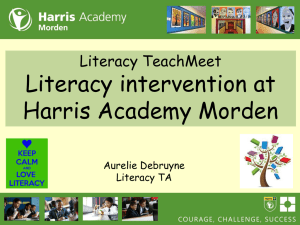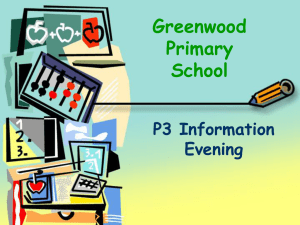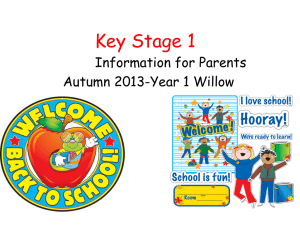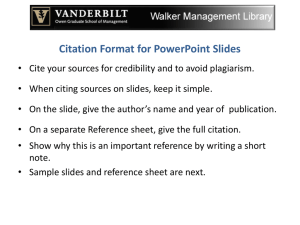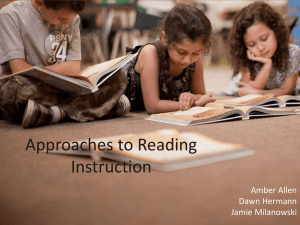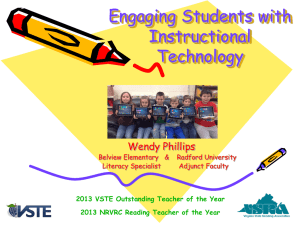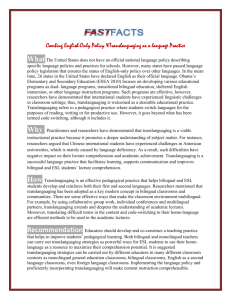Multilingual Literacy: an Integrated Approach
advertisement
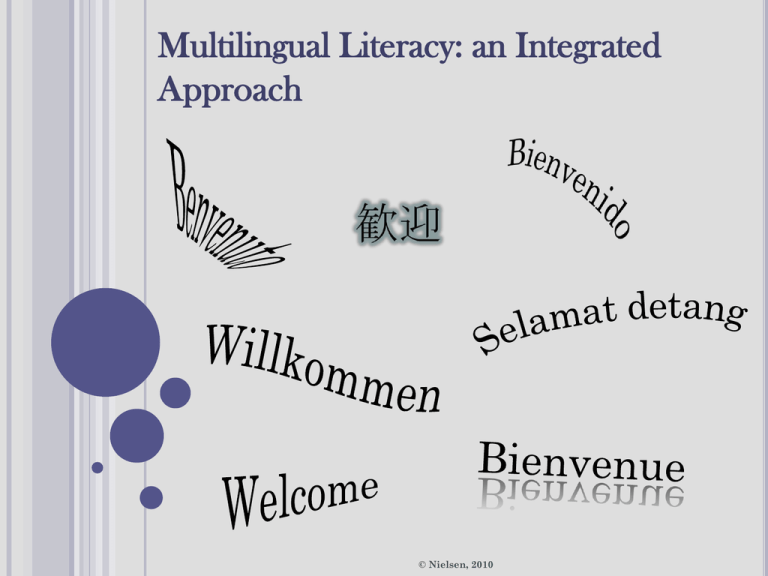
Multilingual Literacy: an Integrated Approach © Nielsen, 2010 RATIONALE Research findings demonstrate that the experiences that enable a child to acquire any language and then to become literate in it follows a predictable developmental pathway. This pathway can therefore be used as a basis for planning an integrated curriculum for learning a first and subsequent languages based on the development of common language proficiencies (Doughty & Long, 2003; Griffin, 2009; Petitto, 2009). The mechanism that drives this developmental interplay is commonly referred to as crosslinguistic transfer (Genesee, Geva, Dressler & Kamil, 2006). There are two abiding frameworks that govern our current understanding of cross-linguistic transfer: 1. Linguistic interdependence (Coady, 1997; Cummins, 1979; Diaz & Klingler, 1991; Verhoeven, 1994) 2. Contrastive analysis (Connor, 1996; Ellis, 1994; Lado, 1957; Odlin, 1989) © Nielsen, 2010 UNDERSTANDING CROSS-LINGUISTIC INTERDEPENDENCE: FROM THEORY TO PRACTICE 1. Linguistic Interdependence: refers to a mutual central processing system from which both languages operate. A common language proficiency. Studies of functional Magnetic Resonance Imaging (fMRI) have identified three main areas of neuronal activation when reading is occurring across languages, all located in the left hemisphere of the brain: Broca’s area (articualtion and word analysis), the parieto-temporal region (sophisticated word analysis – phoneme sequencing, morphological analysis) and the occipito-temporal region (visual processing in fluent reading). UNDERSTANDING CROSS-LINGUISTIC INTERDEPENDENCE: FROM THEORY TO PRACTICE 2. Contrastive analysis: here the focus is also on commonalities between L1 and L2, but in this case the emphasis is on structural similarities between languages. Within this perspective our planning and instructional focus is on identifying and analysing structural (e.g. phonology, syntax, semantic) similarities and differences (Odlin, 1989). Differences may lead to inferential errors, whereas similarities might lead to easier acquisition because the learner may recognise features (phonological forms, cognates) that are common to both languages. Thus the amount of structural abilities should moderate the degree of transfer between L1 and L2 (Connor, 1996; Odlin, 1989). MULTI-LINGUAL LITERACY: AN INTEGRATED APPROACH This approach to languages and literacy teaching is based upon a global principle of in step collaboration between classroom teachers of English (the societal language) and teachers of foreign languages (the target language[s]). The approach is based upon the following core principles: 1. 2. 3. 4. 5. Universal schedules for languages and literacy teaching and learning (sequencing developmental milestones) Developmental scaffolding of language and literacy tasks (within and between - translanguaging) Task analysis and modification (sequenced and tied to purpose/outcomes of schedules) Systematic (diagnostic/criterion, standardised/normed) assessments tied to in step collaborative programming/schedules Naturalist-immersion classroom environment (global oral language development) © Nielsen, 2010 MULTI-LINGUAL LITERACY: AN INTEGRATED APPROACH Tasks that support implementation of the approach in the early years are: 1. Activities for awareness of sounds (phonemes) and systematic phonics use. 2. Activities to build oral language skills (functional, thematic and sight vocabulary). 3. Activities and games to continue to develop and reinforce vocabulary and phonological aspects of language. 4. Developmentally integrated use of these activities across languages: translanguaging. Although the vast majority of today’s educators and teachers grew up with the understanding that the human brain doesn’t physically change based on stimulation it receives from the outside – especially after the age of 3 – it turns out that that view is, in fact, incorrect. (Prensky, 2001, p1) © Nielsen, 2010 DIFFERENCES IN BRAIN ACTIVATION Konza, 2007 © Nielsen, 2010 LITERACY? Literacy is uniquely a schooled thing, and very different to oral language. It is not simply oral language transcribed… (Cope and Kalantzis 2000, p.144.) © Nielsen, 2010 BUZZ… You have all been engaged in contrastive analysis in your planning and with your students over the past year! In school language groups please take 5 minutes to reflect on what you have learned / included in your teaching about the sounds and sound to symbol correspondences across English and the target language. Please record your reflections in your journals. DEVELOPING MULTILINGUAL LITERACY: PHONOLOGY TO SYSTEMATIC PHONICS INSTRUCTION Grapho-phonological Correspondence: mapping phonology Letter-sound Knowledge = The Alphabetic Principle The Alphabetic Principle = Phonics Instruction Syllable-sound Knowledge = The Syllabic Principle The Syllabic Principle = Phonics Instruction (modified) © Nielsen, 2010 UNIVERSAL PHONICS INSTRUCTION: IN STEP PLANNING Within each writing system, orthographies vary in the transparency of mappings between graphemes and phonemes Consequences for phonics instruction? A learner can confidently connect a letter (or durable syllable) to a sound in shallower orthographies but the basis for such confidence wanes as the learner moves to deeper orthographies (English as a “dyslexic” orthography) Perfetti & Dunlap, 2008, p 18 © Nielsen, 2010 PHONICS ACROSS LANGUAGES Learning to read in Spanish undoubtedly requires phonemic awareness and proceeds from a foundation of readiness through a developmental progression of encoding and decoding skills (Estes & Richards 2002, p.222) Hiragana and Katakana symbols represent the sounds of syllables. Each is a kind of alphabet, or syllabary, of 46 basic sounds or characters (Romaji / Hepburn System to Kanji) Akiyama, 2002 A review of the literature to date also indicates that while all languages use syllables to form lexical items (words) they too vary in depth / durability: Language No. Syllables ≈ all words Spanish 35 CV Japanese (Kana) 100 V CV Modern Greek 433 Chinese Siok, Wai Ting (2001) 1200 mono (21 onset; 37 rime) Indonesian 1900 English 3000 © Nielsen, 2010 REFLECTIONS FOR TEACHING… Research shows … Strong correlations between L1 and L2 oral language, decoding and phonological awareness skills … according to the interdependence framework this is due to the development of a common underlying proficiency that serves the skills in both languages. according to the contrastive analysis framework this is due to the extent of similarities between the languages. The learner recognises that some structures (phonemes, graphemes and cognates) are similar in each language and thereby transfer knowledge of these structures from one language to another. Thus, the correlations (or ability to transfer) can be explained from within both frameworks. How do these findings compare with your experiences? HOW HAVE YOU TAUGHT? Interdependence Framework… Contrastive Analysis Framework… WHY? Introduction of a new language does not “damage” or “contaminate” the home language of the child (Petitto et al., 2003) The brains of multilinguals are not deviant to monolingual brains, they overlap the classic language areas that are universally observed in monolinguals (Petitto et al., 2009) Learning of a second alphabetic language enhances and improves students’ literacy outcomes in their first alphabetic language (School of Languages, 2005) That students who average 4 or more years of foreign language study score higher on their Scholastic Aptitude Test (SAT) than those who study 4 or more years in any other area (US College Examination Board) The average mathematics score for individuals who have studied languages for 4 or more years is identical to the average score of those who have spent that same time on extra mathematics study (US College Examination Board) CONNECTING TRANSLANGUAGING WITH ACARA CONNECTING TRANSLANGUAGING WITH ACARA SCAFFOLDING LEARNING BOTH WITHIN AND BETWEEN LANGUAGES: A WAY FORWARD What does research tell us? 1. There is little transfer of oral language knowledge (universal developmental path for content, 30 million) (Melby-Lervåg & Lervåg, 2011) TRANSLANGUAGING ORAL LANGUAGE DEVELOPMENT: SEQUENTIAL FOREIGN LANGUAGE DEVELOPMENT PATTERN Level 1 Vocabulary: building of basic functional nouns. The language of basic social interactions (functional / thematic). Basic classroom language: instructions and interactions. Level 2 Expanding the language of social interactions. Expanding noun vocabulary. Introducing verbs. Level 3 Expand verb and noun vocabulary. Introduce adjectives; emotions, size, describing people. Level 4 Expand on nouns, verbs, and adjectives. Explore verb tenses. Introduce adverbs. Level 5 Continue expanding all areas of vocabulary. Focus on sentence construction. © Nielsen, 2010 SCAFFOLDING LEARNING BOTH WITHIN AND BETWEEN LANGUAGES: A WAY FORWARD What does research tell us? 1. There is little transfer of oral language knowledge (universal developmental path for content) 2. There is a moderate to strong cross-linguistic transfer of decoding skills and phonological awareness (reading comprehension in L1 and L2 - flashcards) 3. There are a number of factors that moderate how strong / successful this transfer can be: 1. 2. 3. Whether the learners are provided with instruction in both L1 and L2 or just L2 (4000 to 1400 hours with translanguaging) The degree of structural similarity between L1 and L2 The age and SES of the learners (decontextualised L1 oral language, a metalanguage). As learners master decoding to the point of automaticity then oral language knowledge becomes more significant for comprehension (receptive, 15 y.o. knows around 13,000 words by sight. 30 million deficit) (Melby-Lervåg & Lervåg, 2011) A WRITING CONTINUUM FROM TALKING TO WRITING TO READING: PERSPECTIVES A Receptive: Hearing and listening B Expressive: Speaking D Receptive: Reading C Expressive: Writing L2 SAY WHAT YOU CAN HEAR, READ WHAT YOU CAN WRITE A. Oral language development: functional, thematic. Nouns and modifiers B. Phonemic awareness C. Decoding skills: segmenting and blending Write what you can actively hear (LSCWC&T) Modelled construction of sentences - build words into phrases (Q & A as class and in pairs) Students practise listening to and saying modelled sentences Students recite in Q & A format or dialogue format with teacher as a whole class the modelled sentences – swap roles and act out Modelled construction with individual adaptations (open-ended co-construction – going beyond fast mapping). Linguistic adaptations may include; adjectives, greetings, number, demonstratives, superlatives, nouns, pronouns etc… Students practise reading aloud what they have written in pairs and as a whole class (compare and contrast different models / different lexical and syntactical constructs) Class co-construction of longer dialogue / script drawing upon known language and integrating new phrases and target vocab Students then use co-constructed model to write their own In pairs, students read and recite what they have written Students present their dialogues to class using drama props – pop-up stages, costumes, wigs, glasses, sombreros, puppets, realia etc… Record on DVD for student reflection and planning and teacher reflection, planning and reporting AN EXAMPLE FROM MY PRACTICE… IN-STEP PLANNING FOR 2011 New Students: 1. Oral language development activities functional, thematic and sight vocabulary 2. Systematic phonics instruction mapping principle for sounds to symbols – decoding and encoding skills, spelling skills Resources: resources on blog + distributed, new books, IWB book / activities, dice activities, flashcards, bilingual songs, classroom language, web sites, lap and big books etc… IN-STEP PLANNING FOR 2011 Continuing Students: 1. Moving oral language (functional, thematic and sight vocabulary) into writing for reading (employing phonics strategies) Class letter/sound book Children’s alphabet books (IWB) Page in class big book Rhyme in pocket chart Class chart with photos and captions Photostory on computers and IWB (ToonTwisters 3D) Joint construction of text: Sharing The Pen SCHOOL PLANNING: 2 COHORTS & 2 CLASSROOM TEACHERS LANGUAGE TEACHERS: WHAT SUPPORT DO YOUR COLLEAGUES NEED IN 2011? New … Assessments Activities … Continuing … Discuss and record in your journals RAY WILLIAMS’ TOP TEN PRINCIPLES FOR TEACHING FOREIGN LANGUAGE READING This article puts forward ten principles for an extensive reading approach to teaching reading. They deal with the nature of extensive reading and the conditions and methodology necessary for its success. Next FUSA session, Term 2? Feedback and TRT accounts Permits
